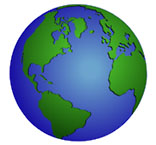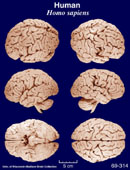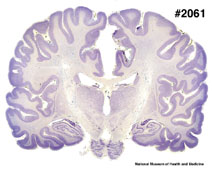|
Human
(Homo sapiens) #69-314 |
||||
|
MSU
Human Brain Atlas
MSU
Atlas of the Human Brain Stem
MSU
Human Hypothalamus Sections
|
Physical
characteristics and distribution
|
|
Human body types vary substantially. Although body size is largely determined by genes, it is also significantly influenced by environmental factors such as diet and exercise. The average height of a North American adult female is 162 centimetres (5 feet 4 inches), and the average weight is 62 kilograms (137 pounds). Human males are typically larger than females: the average height and weight of a North American adult male is 175 centimeters (5 feet 9 inches) and 78 kilograms (172 pounds). Humans are capable of fully bipedal locomotion, thus leaving their arms available for manipulating objects using their hands, aided especially by opposable thumbs. Because human physiology has not fully adapted to bipedalism, the pelvic region and spinal column tend to become worn, creating locomotion difficulties in old age. Humans are omnivorous animals who can consume both plant and animal products. Evidence shows that early Homo sapiens employed a "hunter-gatherer" methodology as their primary means of food collection. This involved combining stationary plant and fungal food sources (such as fruits, grains, tubers, and mushrooms) with wild game which must be hunted and killed in order to be consumed. However, many modern humans choose to be vegans or vegetarians. Additionally, it is believed that humans have used fire to prepare food prior to eating since the time of their divergence from Homo erectus, possibly even earlier. The original human lifestyle was hunting-gathering, which was adapted to the savanna. Other human lifestyles are nomadism (often linked to animal herding) and permanent settlements made possible by the development of agriculture. Humans have a great capacity for altering their habitats by various methods, such as agriculture, irrigation, urban planning, construction, transport, and manufacturing goods. Permanent human settlements are dependent on proximity to water and, depending on the lifestyle, other natural resources such as fertile land for growing crops and grazing livestock, or seasonally by populations of prey. With the advent of large-scale trade and transport infrastructure, proximity to these resources has become unnecessary, and in many places these factors are no longer a driving force behind growth and decline of population. Human children are born after a nine-month gestation period, and are typically 34 kilograms (69 pounds) in weight and 5060 centimeters (2024 inches) in height in developed countries. Helpless at birth, they continue to grow for some years, typically reaching sexual maturity at twelve to fifteen years of age. Boys continue growing for some time after this, reaching their maximum height around the age of eighteen. The human life span can be split into a number of stages: infancy, childhood, adolescence, young adulthood, maturity and old age. The view most widely accepted by the anthropological community is that the human species originated in the African savanna between 100 and 200 thousand years ago, had colonized the rest of the Old World and Oceania by 40,000 years ago, and finally colonized the Americas by 10,000 years ago. Homo sapiens displaced groups such as Homo neanderthalensis, Homo erectus and Homo floresiensis through more successful reproduction and competition for resources. Distribution of humans is cosmopolitan. Technology has allowed humans to colonize all of the continents and adapt to all climates. Humans have explored Antarctica, the ocean depths, and space, although long-term habitation of these environments is not yet possible. Humans, with a population of over six billion, are one of the most numerous of the large mammals. Most humans (61%) live in Asia. The vast majority of the remainder live in the Americas (14%), Africa (13%) and Europe (12%), with 5% in Oceania. Humans, with a population of over six billion, are one of the most numerous of the large mammals. |
|
Description
of the brain
|
|
Animal
source and preparation
|
|
All
specimens collected followed the same preparation
and histological procedure.
|
Other Related Resources (websites and publications)
List of Specimens | Explore Collections | Brain Sections | Brain Evolution | Brain Development | Brain Circuitry | Brain Functions | Location and Use | Related Web Sites | Contact Us | Search MSU Database | Personnel | Home



